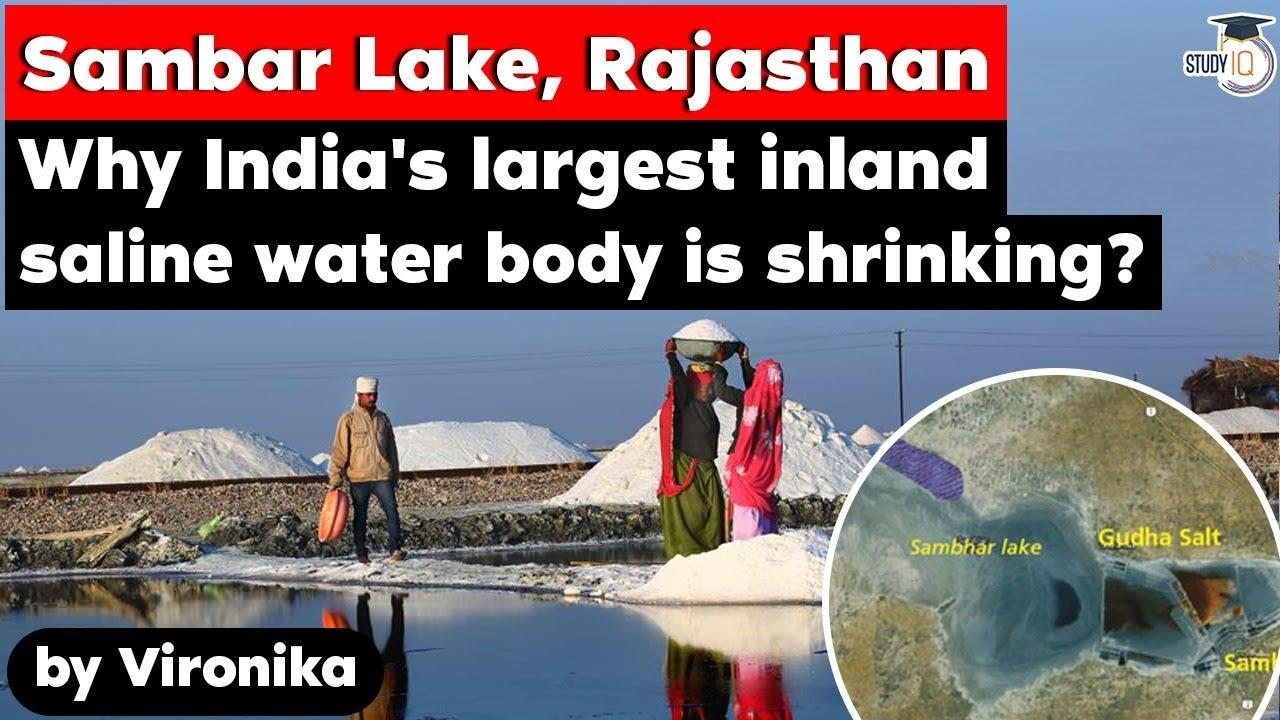Table of Contents
- The world famous Sambhar Salt Lake in Rajasthan, which is constantly shrinking with the degradation of soil and water quality and a decline in the population of migratory birds, needs a faster restoration for conservation of its wetland and salt brine worth $300 million.
Sambhar Lake
- The lake, situated 80 km south-west of Jaipur, is the country’s largest inland saline water body which attracts thousands of migratory birds every year.
- The lake receives water from six rivers: Mantha, Rupangarh, Khari, Khandela, Medtha and Samod.
- Sambhar has been designated as a Ramsar site because the wetland is a key wintering area for tens of thousands of pink flamingos and other birds that migrate from northern Asia and Siberia.


- The death of more than 20,000 birds due to avian botulism, which migrate annually to the lake had made international headlines in 2019.
- It is famous for the production of brine/salt,houses one of the largest salt manufacturing units in the country.
Major Threats
- Almost 30% of the Sambhar Lake’s areahad been lost to mining and other activities, including the illegal salt pan encroachments.
- The loss in the area has also threatened the livelihoods of local people who have always lived in harmony with the lake and its ecology.
- TheAravalli hills have decreased by 0.1% (as compared to in 1971). The hill has been a natural barrier limiting the salt from spreading into other fertile areas.
- If this natural wall continues to fall it will force the people to migrate.
Threat for the Migratory Birds

- The birds foraging in the Sambhar marshlands had died due to avian botulism.
- The death of more than 20,000 birds belonging to about 10 specieswhich migrate annually to the lake due to avian botulism in 2019.
Key Recommendation
- The study, undertaken by a research team of the Central University of Rajasthan’s School of Earth Sciences, has recommended an urgent action to restore the lake’s ecosystem for protecting the birds and biodiversity as well as the salt production.
Mining Menace
- 30% of the Sambhar Lake’s area had been lost to mining and other activities, including the illegal salt pan encroachments.
- It has also threatened the livelihoods of local people who have always lived in harmony with the lake and its ecology.
- The study team conducted geospatial modelling for 96 years, from 1963 to 2059, at a decadal scale with the integration of ground data on birds, soil and water.
- The satellite images were classified to cover Aravalli hills, barren land, saline soil, salt crust, salt pans, wetland, settlement and vegetation.
- While the past trends showed a reduction of wetland from 30.7% to 3.4% at a constant rate with its conversion into saline soil, which increased by 9.3%, the future predictions had depicted a loss of 40% of wetland and 120% of saline soil and net increase of 30% vegetation, 40% settlement, 10% salt pan and 5% barren land.
Avian Botulism in Sambhar Lake
- The avian botulism is a neuro-muscular illness caused by Botulinum (natural toxin) that is produced by a bacteria — Clostridium botulinum.
- The bacteria are commonly found in the soil, rivers, and seawater. It affects both humans and animals.
- The bacteria also need anaerobic (absence of oxygen) conditions and do not grow in acidic conditions.

- It affects the nervous system of birds, leading to paralysis in their legs and wings.
- The outbreaks of avian botulism tend to occur when average temperatures are above 21 degrees celsius, and during droughts.
Question:
Which one of the following is an artificial lake?
- (a) Kodaikanal (Tamil Nadu)
- (b) Kolleru (Andhra Pradesh)
- (c) Nainital (Uttarakhand)
- (d) Renuka (Himachal Pradesh)
Latest Burning Issues | Free PDF




























 WhatsApp
WhatsApp